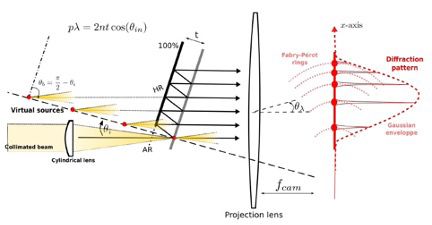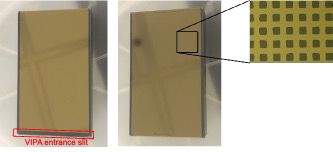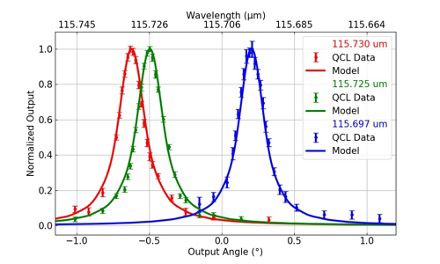New far-infrared sensor optics technology for understanding planet formation
New far-infrared sensor optics technology for understanding planet formation
Project:
Enable far-infrared velocity-resolved spectroscopy in compact instrumentation for exoplanet formation.
Mission Applications:
Current flight applications of this technology include the following sub-mitted astrophysics mission proposals: The Planetary Origins and Evolution Multispectral Mon-ochrometer POEMM (Pioneer class balloon) and the Far-Infrared Spectroscopic Space Tele-scope FIRSST (Probe class).
Snapshot:
We have demonstrated the operation of a Virtually Imaged Phased Array (VIPA) in the far-infrared. The VIPA is a transformative technology for velocity resolved spectroscopy enabling missions that can locate the major building blocks of planets including H2 (through its isotopic variant, HD), water, and oxygen at sub-AU scales thereby tracing the formation of planets such as our own.
How do planets form and evolve to produce habitable environments? The answer is encoded in the light they reflect and emit. Here we report on new technology for extracting this information from the light of circumstellar disks - the birthplaces of planets. The sharpest tool in the shed for extracting information from starlight is a technique called spectroscopy. The advanced capability discussed here will enable astronomers to spectroscopically measure the Keplerian orbital motion of molecules such as water, in circumstellar disks. This new capability can reveal how the chemistry of these disks changes with distance from the star through a process called tomography. With this approach, scientists can, for example, measure the distance from the star at which water vapor in the disk transitions to water ice (known as the “snow line”) which is key to understanding planet formation.
He we report on a new sensor optics component that enables gas velocity as low as 3 km/s to be measured on astronomical sources in the far-infrared spectrum where key molecules have prominent spectral features. This optic is known as a Virtually Imaged Phased Array (VIPA). It enables high spectral resolution with no moving parts in a compact configuration to facilitate development of compact science instrumentation for spaceflight and balloon astronomy.
A team of researchers from Cornell University and Goddard Space Flight Center, led by Prof. Gordon Stacey from Cornell University, has fabricated, and demonstrated the first prototype VIPA for far-infrared spectroscopy. This liquid helium cooled VIPA provides a first proof of concept for employing such devices in far-infrared missions that require spectral resolving powers, Δ/Δλ, of order 100,000. When coupled with direct detection detectors, VIPA spectrographs will deliver unsurpassed sensitivities in the far-infrared.
A VIPA (Figure 1) produces a dispersed spectrum like that of a diffraction grating. The light enters the VIPA at an angle through a slit. It bounces within two fixed parallel surfaces where one surface has a reflectivity of 100% while the exit surface has a reflectivity of order 90%. The resonant conditions between the mirror surfaces for different wavelengths are met for specific angles. Therefore, the light exits the VIPA at an angle that is a function of wavelength producing an instantaneous spectrum along a dispersion direction.

Figure 1: Schematic of the operation principle of a VIPA (Bourdarot et al. 2018 SPIE, 107025Y)
Cornell PhD student Bugao Zou and former graduate student Nick Cothard (now at GSFC) have fabricated the 3 x 5 cm size and 1 cm thick VIPA prototype out of a puck of high-purity silicon that was provided by Edward Wollack (GSFC). The size of the available high-purity silicon puck from which we cut the rectangular cuboid set stringent limitations on the resolving power of this demonstration. By using the electromagnetic field simulation software CST Studio, we estimated the optimal surface metallization parameters to achieve resolving powers of order 15,000 with our prototype. The entrance side of the VIPA was fully metallized (gold-coated, 100% reflective), except for the entrance slit, while the exit side of the VIPA was metallized with a gold mesh, resulting in a reflectivity of 89% at 115 microns (Fig. 2). The entrance slit of the VIPA was left bare, without any anti-reflection coating.

Figure 2: The VIPA prototype is a 3×5×1 cm silicon block with gold metallized surfaces. On the left is the fully metallized entrance side and in the middle is the metal mesh exit side. The insert is a microscope image of the gold metal mesh pattern on the exit side of the VIPA. The pitch of the pattern is 27.5 µm and the hole width is 14.8 µm.
The performance of the VIPA prototype was characterized on a customized testbed that included a Quantum Cascade Laser (QCL) as the radiation source and a pyroelectric single pixel detector. The QCL and the detector were very kindly provided by LongWave Photonics. Fig. 3 shows a schematic of the main components of the testbed. The QCL was mounted inside a small separate cryostat and cooled by vacuum pumping the liquid N2 down to a temperature of about 52 K. The beam from the QCL was refocused at an iris mask with the diameter set to about 2 mm. An off-axis parabola mirror picks up the beam and sends a collimated beam into the liquid-Helium cooled VIPA cryostat. Within that cryostat a cylindrical concave mirror focuses the radiation at the exit side of the VIPA. The entrance slit of the VIPA is thus slightly upstream of the focus. The radiation then travels inside the VIPA and emits a collimated beam. Depending on the frequency of the radiation the resonant conditions of the VIPA direct the radiation into specific angles, hence disperses the radiation. An off-axis parabola mirror collects the emerging dispersed collimated beams from the VIPA and delivers them to a focal plane, where a single pixel pyroelectric detector with a 0.25 mm entrance slit detects the radiation. By moving the detector along the dispersion direction, we can trace the transmission profile of the VIPA for a specific frequency that was set by the QCL. We have varied the QCL frequency to various values around 2.59 THz by changing the operation voltage of the QCL, and at each frequency setting we have probed the dispersion direction with the pyroelectric detector.

Figure 3: Schematic of the optical arrangement of the testbed for characterizing the prototype VIPA.
The result of the VIPA dispersion measurements is shown in Fig. 4. It shows the data points of the VIPA transmission profile probed with the detector as well as the CST simulations for three different QCL frequencies. The plot shows the excellent match of the simulations with the observed data and that the VIPA achieved the designed resolving power of ~15,000 at 115 microns. Our measurement shows that we can accurately simulate and predict the VIPA performance and thus can obtain the proper parameters to fabricate a VIPA. The next step in our effort is to build an improved testbed that will allow us to better characterize the next VIPA which will be designed for resolving powers of 100,000.

Figure 4: Measured VIPA transmission profile at three different QCL frequencies. The measured data is shown as dots with error bars, and the simulations are shown as solid lines.
Project Lead(s):
Professor Gordon Stacey, Cornell University, Dr. Karwan Rostem, NASA Goddard Space Flight Center
Sponsoring Organization(s):
This work was supported by GSFC Internal Research and Development funding and NASA Astrophysics Research and Development (APRA) grants NNX16AC72G and 80NSSC24K0041 to Cornell University.
Key terms:
Velocity Resolved Spectroscopy, Direct Detection, Far-Infrared, Origins of Planets, Water Trail
